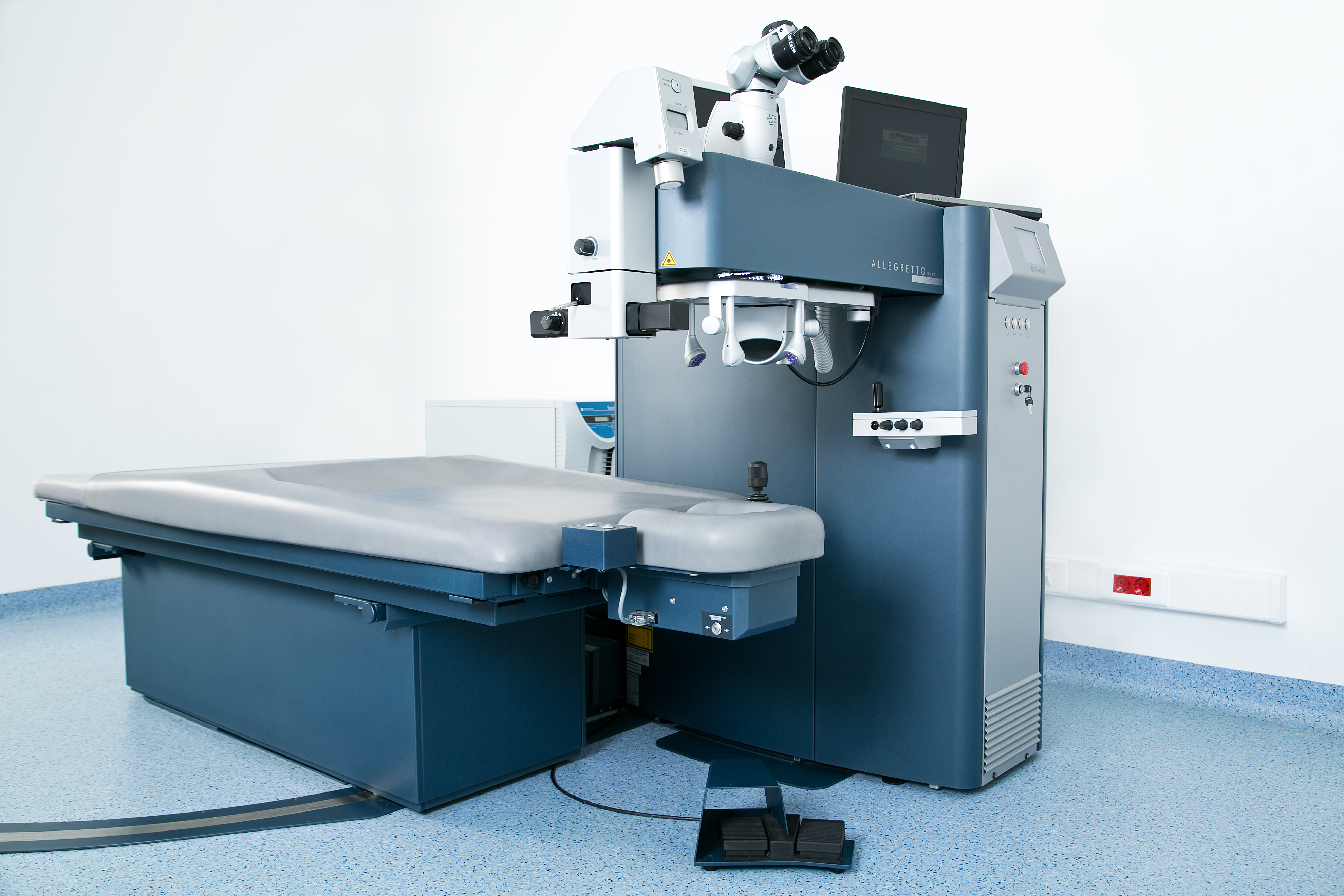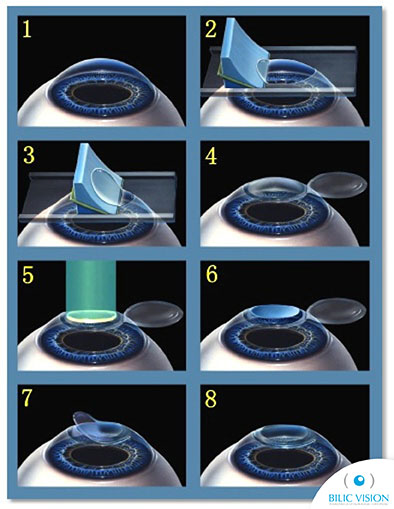Are you tired of prescription glasses or contact lenses? In winter your glasses are fogging up, and in summer they are slipping down your nose? Every third day you fall asleep wearing them and they keep twisting? If any of these problems is yours, too, then laser eye surgery is the ideal solution for you.
Laser eye surgery is the choice of patients who want to get rid of all vision aids and enable themselves to work at the computer uninterruptedly, drive (during day and night), read and do sports (it is possible to do even extreme and professional sports after laser eye surgery).
At the Polyclinic Bilić Vision we have helped a number of professional athletes to become better and feel more carefree after laser eye surgery. Additionally, in cases of a high diopter, glasses constrict the visual field, while wearing a lens is a burden that requires discipline, good hygienic habits, and knowledge about proper handling techniques of contact lenses. Also, it is possible to develop allergies or dry eye syndrome over time.
You are a good candidate for laser eye surgery if you are older than 18 and have a stable diopter.
Before we can determine with a 100% confidence that you are a good candidate for laser eye surgery, a detailed ophthalmological preoperative examination is required. If the candidate has any of the following contraindications, laser diopter surgery is not recommended to a candidate who has any of the following conditions:
It is important to emphasize that people over 40 years of age after laser surgery will have a good distance vision. However, for reading they will have to wear glasses just like all their peers. Also, in case of farsightedness, several months or several years after the surgery, partial diopter can reappear. This depends on genetics, preoperative diopter, and the healing processes. Additional diopter corrections are possible if there is enough remaining corneal tissue.
Laser eye surgery has been the most frequently occurring ophthalmic surgery in the world over the past 10 years. Polyclinic Bilić Vision is a specialized medical institution established 20 years ago, and in laser eye surgery we have a ten-year experience. At the Polyclinic Bilić Vision laser eye surgery is performed by Dr. Sc. Nadežda Bilić, a specialist in eye diseases, particularly educated in the field of diagnosis and treatment of the anterior eye segment, refractive surgery (laser surgery), cataract surgery, immunology, eye allergies and diseases manifested on the eye.
During her many years in ophthalmology, she has gained her expertise in eminent clinics in the United States, Germany, Spain (Barraquer Clinic in Barcelona), Australia, Russia, etc., with whom she still cooperates professionally. Dr. Sc. Nadežda Bilić has operated on several thousand patients in the past ten years and has helped them to successfully discard their glasses and vision aids forever. In Cologne, Germany, she completed her training for a refractive surgeon in 2002. Every year as a lecturer or participant she takes part in congresses of refractive surgeons all over the world, with the aim of implementing new knowledge and technologies in the activity of Polyclinic Bilić Vision.
We would like to emphasize the fact that at Polyclinic Bilić Vision we use the modern technology of Wavelight Alegretto 4th Generation Laser. Wavelight is the company that manufactures the most technologically advanced laser for refractive surgery (laser surgery).

If you are considering the possibility of laser eye surgery, make a no-obligation telephone call.
We will be very happy to answer all of your questions and concerns and sign you up for a preoperative examination or free consultation. Call us on the following number: +385 1 4678-444.
It is important to note that the patients wearing glasses do not need to be specially prepared for the preoperative examination for laser correction of visual acuity, while the patients wearing soft contact lenses should be without them 3 days prior to the scheduled examination.
If you wear semi-hard or hard contact lenses, you must be free of lenses for at least 8 days, so that the diopter can be accurately measured and examined in the best possible way. Before the surgery, people wearing soft contact lenses should be free of them for two weeks, and those wearing semi-hard and hard lenses for at least four weeks.
The preoperative examination is very detailed, it lasts about an hour and a half and after that the physician can safely say whether you are a good candidate for laser eye surgery.
The preoperative examination consists of:
If the preoperative examination shows that you are a good candidate for laser surgery, we will schedule an operation that you will not have to wait for more than 5 workdays.
On the day of surgery it is normal to feel a little nervous, but do not worry. If you have had a thorough examination prior to laser surgery we do at the Polyclinic Bilić Vision, it is certain that we have studied your eyes to the slightest detail, which is essential for the successful outcome of the operation.
No special preoperative preparation is required on the day of the procedure, although it is important to note that it is necessary to take someone with you. Before the surgery, several more tests are repeated, and the eyes are anesthetized by anesthetic drops. When anesthesia begins to work, the patient is placed on the laser bed.
LASIK is today the most common form of surgery because it gives excellent results right after the surgery and studies have shown that patients are more satisfied after the LASIK method than after the PRK method (weaker postoperative pain and faster visual recovery).
LASIK operation is very short and painless, and the laser surgery itself consists of two phases. In the first one, a corneal flap is formed, and in the second phase, the laser removes the diopter and the flap is self-healing.
LASIK can be applied to all the aforementioned diopters. As a rule, both eyes are operated on at once. Recovery is quick, and the vision is almost normal again tomorrow. We also apply individualized approach to each patient using "Wave Scan Technology" that detects all corneal irregularities and gives us an insight into the objective diopter of the patient. lasersko skidanje dioptrije

1. Eye before surgery
2, 3, 4. Forming the corneal flap with a mikrokeratome
5. Laser eye surgery
6. Cornea after the laser activity
7. Recovering the flap in place
8. Cornea after the procedure
LASIK surgery is completely painless and is performed under drop anesthesia. The procedure for both eyes lasts for about 30 minutes, although the laser works on the cornea for only 10 seconds, depending on the height of the diopter. After the LASIK surgery, patients go to work after 1 to 2 days.
PRK is a method that is applied mainly in lower diopters and thinner corneas. During surgery the epithelium of the cornea is removed and the laser directly removes the diopter, with no incisions on the cornea. In the postoperative course following the PRK method, the corneal epithelium spontaneously heals in 2-3 days. By applying the PRK method, visual recovery is a bit longer, and - as with the LASIK method - both eyes are operated on at the same time.
Visual recovery lasts up to 3-4 weeks, and the method can be applied to:
The advantages of PRK Method:
In the postoperative course, antibiotic drops need to be applied for a week, and artificial tears for the next 2-3 months. You can normally return to regular life activities and sports two weeks after the operation.
If a patient has corneas with a corresponding thickness (550 microns, normal corneal thickness), and the diopter is in the range of -10.00 diopter up to +5.00 diopter, he or she can choose the method in agreement with the physician. In cases of thinner corneas (thickness less than 500 microns), the method used is PRK. However, in every case, before a physician decides for one of the methods offered during consultations with a patient, a detailed preoperative examination is required to determine all the parameters needed to make the optimal decision.
You will probably notice a huge change as soon as you get up from the laser position, although it's important to emphasize that your vision will improve each day in the next few months. With your new vision, you will see how much more beautiful every day is, as you notice little things that were not part of your experience of the world around you. We will provide for you safe and successful recovery by continuous monitoring through the follow-up examinations.
The operated patient does not have his eye closed with a bandage. He or she puts on dark and large enough sunglasses to protect them from external influences (wind, rain, sun, dust, artificial illumination, etc.).
The first day after the surgery the patient must wear sunglasses even at home, indoors, all the time. During the first two weeks after surgery, sunglasses should be worn if the patient leaves home. The first follow-up examination is one day after the surgery, the second after a week, the third after a month, the fourth after three months, the fifth after six months, the sixth after 12 months.
The operated patient returns to work after three days. The only exceptions are patients working in conditions where they are exposed to wind, dust, and other adverse conditions that may, in the early stages of healing, have a bad effect on the eye, i.e. create certain complications in the healing phase and cause inflammation. We recommend that these patients stay at home for two weeks. The patient can do aerobic sports two weeks after surgery, sports that cause stress (weight lifting or going to the gym) must be avoided for a month, and contact sports (martial arts, handball, football) must be avoided for 3 months. The patient can swim in the sea after 2 weeks and in the pool after a month.
Prolonged dryness of the eye occurs in all patients and lasts for about a month. The patient feels discomfort, has a feeling of sand in his or her eyes, but this can be relieved by regular application of artificial tears 6-8 times a day.
Other complications are rare (less than 2% of operated patients) and manifest themselves in the form of a partial return of the diopter, epithelial cells’ growth under the flap or in the form of micro lesions. These complications cannot be predicted because they depend on the individual potential of tissue healing. We emphasize that all complications can be resolved and that none can lead to loss of vision.
To avoid complications, careful patient selection, detailed medical history and thorough examination before surgery are required.
Laser eye surgery includes:
Laser eye surgery does not include:
Become a part of the Polyclinic Bilić Vision family of satisfied patients and call today to be informed of the laser eye surgery. You can make an appointment over the phone: +385 1/4678-444 or by email info@bilicvision.hr.
Need more information? Can't find what you are looking for or want to make a doctor's appointment? Leave your information and we will contact you as soon as possible:
Vaš upit je zaprimljen! Hvala Vam na povjerenju!